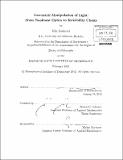Geometric manipulation of light : from nonlinear optics to invisibility cloaks
Author(s)
Hashemi, Hila
DownloadFull printable version (20.46Mb)
Other Contributors
Massachusetts Institute of Technology. Dept. of Mathematics.
Advisor
Steven G. Johnson.
Terms of use
Metadata
Show full item recordAbstract
In this work, we study two different manipulations of electromagnetic waves governed by macroscopic Maxwell's equations. One is frequency conversion of such waves using small intrinsic material nonlinearities. We study conversion of an input signal at frequency w1 to frequency Wk due to second or third harmonic generation or four-wave mixing using coupled-mode theory. Using this framework, we show there is a critical input power at which maximum frequency conversion is possible. We study in depth the case of third harmonic generation, its solutions, and their stability analysis. Based on the dynamics of the system, we propose a regime of parameters that 100%- efficient frequency conversion is possible and propose a way of exciting this solution. We also look at same analysis for the case of degenerate four-wave mixing and come up with 2d and 3d designs of a device that exhibits high-efficiency second-harmonic generation. Second, we consider proposals for invisibility cloaks to change the path of electromagnetic waves in a certain way so that the object appears invisible at a certain frequency or a range of frequencies. Transformation-based invisibility cloaks make use of the coordinate invariance of Maxwell's Equations and require complex material configuration e and p in the cloak. We study the practical limitations of cloaking as a function of the size of the object being cloaked. Specifically, we study the bandwidth, loss, and scattering limitations of cloaking as the object gets larger and show that cloaking of objects many times larger than the wavelength in size becomes practically impossible.
Description
Thesis (Ph. D.)--Massachusetts Institute of Technology, Dept. of Mathematics, 2012. Cataloged from PDF version of thesis. Includes bibliographical references (p. 189-203).
Date issued
2012Department
Massachusetts Institute of Technology. Department of MathematicsPublisher
Massachusetts Institute of Technology
Keywords
Mathematics.